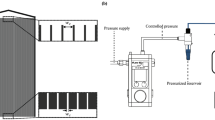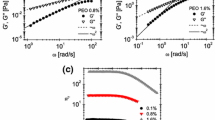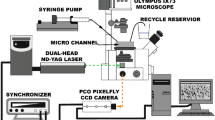Abstract
Given their small size, microchannels are susceptible to being blocked by small amounts of solid matter. The lifetime of certain microfluidic devices depends on their ability to maintain flow without interruption, and certain microfluidic applications require devices that include the transport of either liquids that may contain impurities or liquids that intentionally contain particles. Under the conditions studied in the present experiments, flow-stopping blockages were observed for the flow of liquids with the surprisingly low volume concentrations of ϕ = 0.005–0.056 of polystyrene particles (dp of the order of tens of microns) through circular microtubes with diameters (D) of the order of 100 μm. The quantity of interest is the occurrence of a flow-stopping blockage in the flow of a suspension of hard spheres, over the range of \(\bar d_{\rm p}/D\) from 0.2 to 0.5 and ϕ < 0.06. The percentage of runs for which a blockage did or did not occur versus nominal dp/D is presented. Given that higher concentrations of particles have been used in many previous studies of suspension flows, the occurrence of blockages at these concentrations was initially unexpected. Based upon the data and the parameters varied in the current study, the blockages are more likely to occur when the nominal particle-to-tube diameter ratios are approximately 0.3–0.4.




Similar content being viewed by others
Abbreviations
- d p :
-
Particle diameter
- \(\bar d_{\rm p}\) :
-
Mean particle diameter
- D :
-
Microtube diameter, characteristic dimension
- J :
-
Probability of jamming
- ϕ:
-
Volume concentration
- ρ:
-
Fluid density
- \(\sigma _{d_{\rm p}}\) :
-
Standard deviation of particle diameter distribution
References
Fuller SB, Wilhelm E, Jacobsen JM (2002) Ink-jet printed nanoparticle microelectromechanical systems. J Microelectromech Syst 11(1):54–60
Gregory J (1981) Flocculation in laminar tube flow. Chem Eng Sci 36(11):1789–1794
Hong D, McLennan JA (1992) Molecular dynamics simulations of hard sphere granular particles. Physica A 187:159–171
Karnis A, Goldsmith HL, Mason SG (1966) The kinetics of flowing dispersions. I. Concentrated suspensions of rigid particles. J Colloid Interf Sci 22:531–553
Oleschuk RD, Jemere AB, Shultz-Lockyear LL, Fajuyigbe F, Harrison DJ (2000) Utilization of bead based reagants in microfluidic systems. In: van den Berg A, Olthuis W, Bergveld P (eds) Micro total analysis systems. Kluwer, Netherlands, pp 11–14
Secomb T, Hsu R (1996) Motion of red blood cells in capillaries with variable cross-sections. J Biomech Eng–T ASME 118(4):538–544
Ségre G, Silberberg A (1962) Behaviour of macroscopic rigid spheres in Poiseuille flow. Part 2. Experimental results and interpretation. J Fluid Mech 14:136–157
Ségre G, Silberberg A (1963) Non-Newtonian behavior of dilute suspensions of macroscopic spheres in a capillary viscometer. J Colloid Sci 18:312–317
Sharp K (2001) Experimental investigation of liquid and particle-laden flows in microtubes. PhD thesis, University of Illinois at Urbana-Champaign
Sharp KV, Adrian RJ (2001) Shear-induced arching of particle-laden flows in microtubes. In: 2001 ASME international mechanical engineering congress and exposition, November 11–16, New York, NY, IMECE2001/MEMS-23879, vol. 2 CD
To K, Lai P-Y, Pak H (2001) Jamming of granular flow in a two-dimensional hopper. Phys Rev Lett 86(1):71–74
To K, Lai P-Y, Pak H (2002) Flow and jam of granular particles in a two-dimensional hopper. Physica A 315:174–180
Tsai J-C, Losert W, Voth GA, Gollub J (2001) Two-dimensional granular Poiseuille flow on an incline: Multiple dynamical regimes. Phys Review E 65, 011306.1–0.11306.13
Vand V (1948) Viscosity of solutions and suspensions, Part II. Experimental determination of the viscosity-concentration function of spherical suspensions. J Phys Colloid Chem 52:300–314
Ward S, Whitmore R (1950) Studies of the viscosity and sedimentation of suspensions. Part 1: The viscosity of suspension of spherical particles. Brit J Appl Phys 1(11):286–290
Yamaguchi E (2005) Personal communication
Author information
Authors and Affiliations
Corresponding author
Additional information
Research partially supported by Defense Advanced Research Projects Agency (DARPA), Microsystems Technology Office (MTO) Grant#F33615-98-1-2853 and The National Science Foundation under grant No. CTS-0348149
Rights and permissions
About this article
Cite this article
Sharp, K.V., Adrian, R.J. On flow-blocking particle structures in microtubes. Microfluid Nanofluid 1, 376–380 (2005). https://doi.org/10.1007/s10404-005-0043-x
Received:
Accepted:
Published:
Issue Date:
DOI: https://doi.org/10.1007/s10404-005-0043-x




